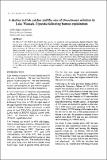A decline in Fish catches and the size of Oreochromis niloticus in Lake Wamala (Uganda) following human exploitation
View/
Author
Date
1995Type
Articleviews
downloads
Metadata
Show full item record
Abstract/
The fishery of Lake Wamala has declined since the lake was stocked in 1956 and opened to fishing during the 1960s. Surveys were conducted on the lake during 1975178 and 1988/92 to investigate the causes of declining fish catches. The lake produced an average of 4000 - 6000 tonnes of fish annually from 1960s through 1970s. Total fish catches decreased from a maximum of 7100 tonnes in 1967 to less than 500 tonnes by 1990s. Catch rates decreased from about 8 kg in the 1960s to less than 1 kg per net per night by 1975. During the 19705 the catch was dominated by Oreochromis niloticus (67%) followed by Clarias gariepinus (17%), and Protopterus aethiopicus (15.1 %). By 1990s the roportion of O. niloticus had decreased to 45.1 % while that of P. aethiopicus had increased to 37.6%. These changes seem to have been caused by overfishing resulting from increased fishing effort from the recommended 250 to about 1000 boats and the additional increase in effort through driving fish into the nets by beating water. The maximum size of O. niloticus in the fishery decreased from 32 cm total length in 1975178 to 22 em in 1988/92 while the size at first maturity decreased from about 21 em to 14 cm during the period. This has been concurrent with a shift in the mesh size of gillnet used from 127 mm (5") in 19605 to 64 mm by 1990s. Environmental changes, especially in lake level in 1980, may also have affected the fishery.

